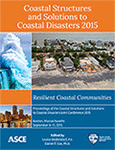Coastal Structures and Solutions to Coastal Disasters Joint Conference 2015
Terminal Groin and Beach Restoration at Folly Beach County Park, South Carolina
Publication: Coastal Structures and Solutions to Coastal Disasters 2015: Resilient Coastal Communities
ABSTRACT
Folly Beach County Park (FBCP) is situated along ~1,000 meters (m) or ~3,300 feet (ft) of shoreline at the southwestern end of Folly Beach near Charleston, South Carolina, U.S.A. Net sand transport is east to west with the adjacent inlet tending to draw sand from the oceanfront. Nourishment in the form of navigation channel disposal and a 50-year federal shore protection project helped maintain the unstabilized spit at FBCP for many years. However, lack of beach fills after 2005 resulted in dune line recession of over 36 m (~120 ft) in five years, loss of parking facilities, and exposure of underlying marsh sediments along the oceanfront. The authors were retained by the Charleston County Park and Recreation Commission (CCPRC) to evaluate the erosion and outline alternatives for restoration. A total of 317,300 m3 (415,000 cubic yards) nourishment and a 225-m (745-ft) steel sheet pile groin with a concrete cap and armor stone toe protection were determined as the optimal means of restoring and maintaining a recreational beach and protecting park infrastructure. The groin at FBCP was designed to follow the local beach profile to the extent practicable in order to reduce the exposure of the structure. It was composed of three sections: berm, beach face, and low-tide terrace. The berm section served to hold the major dry-beach fillet on the updrift side and a minor fillet on the downdrift side, and the beach-face section followed the average slope of the beach across the intertidal wave swash zone. The low-tide terrace section stabilized the profile above the low watermark, and a scour apron of quarry stone was designed at the seaward end of this section for toe protection. Beach nourishment started on 5 May 2013 and finished in 20 days on 24 May. The groin construction was completed over 35 days between 15 May and 19 June 2013. The project was completed on time and without any environmental incident. FBCP re-opened on 3 July 2013 and remains a premier recreational destination in the Charleston area. The American Shore and Beach Preservation Association (ASBPA) announced in May 2015 that the FBCP project is a winner of its 2015 Best Restored Beach award for its successful enhancement of storm protection, habitat restoration, and recreation restoration.
Get full access to this article
View all available purchase options and get full access to this chapter.
REFERENCES
ASCE. 1994. Coastal Groins and Nearshore Breakwaters. Technical Engineering and Design Guides as Adapted from the US Army Corps of Engineers, No 6, American Society of Civil Engineers, New York, NY, 87 pp.
Basco, DR, and J Pope. 2004. Groin functional design guidance from the Coastal Engineering Manual. Jour of Coastal Research, Spec Issue 33, pp 121-130.
CSE. 2012a. Phase 1 planning for Folly Beach County Park stabilization project, Folly Beach, South Carolina. Planning Report for Charleston County Park & Recreation Commission, Charleston, SC, 47 pp + appendices.
CSE. 2012b. Updated analysis of potential downdrift impacts for Folly Beach County Park stabilization project, Folly Beach, South Carolina. Supplementary Report #3 for US Army Corps of Engineers (USACE), Charleston, SC, 117 pp.
CSE. 2013. 2013 Beach restoration and groin construction, Folly Beach County Park, Folly Beach, South Carolina. Final Report for Charleston County Park & Recreation Commission, Charleston, SC, 69 pp + appendices.
Dean, RG. 2002. Beach Nourishment: Theory and Practice. World Scientific, NJ, 399 pp.
Ebersole, BA, PJ Neilans, and MW Dowd. 1996. Beach-fill performance at Folly Beach, South Carolina (1 year after construction) and evaluation of design methods. Shore & Beach, Vol 64(1), pp 11-26.
Hansen, M, J Pope, JD Rosati, and SC Knowles. 1987. Evaluation of the impact of Charleston Harbor jetties on Folly Island, South Carolina. Tech. Rept., CERC, Department of the Army, WES, COE, Vicksburg, Miss., 67 pp. + app.
Jones, CP. 1989. Shoreline assessment and shorefront management alternatives for Folly Beach County Park. Final Report to Charleston County Park & Recreation Commission, Charleston, SC; CSE, Columbia, SC, 62 pp.
Kamphuis, JW. 2000. Introduction to Coastal Engineering and Management. World Scientific Publishing Co Inc, Hackensack, NJ, 437 pp.
Kana, TW, TE White, and PA McKee. 2004. Management and engineering guidelines for groin rehabilitation. In NC Kraus and RL Rankin (eds), Jour Coastal Research, Special Issue 33, pp 57-82.
Traynum, S.B., TW Kana, and D.R. Simms. 2010. Construction and performance of six template groins at Hunting Island, South Carolina, Shore & Beach, Vol. 78, No. 3, pp 21-32.
USACE. 1991. General design memorandum: Folly Beach, South Carolina, shore protection project. Vol II, Tech Repts, U.S. Army Corps of Engineers, Charleston District, SC, various pages.
Information & Authors
Information
Published In
Coastal Structures and Solutions to Coastal Disasters 2015: Resilient Coastal Communities
Pages: 18 - 28
Editors: Louise Wallendorf, U.S. Naval Academy and Daniel T. Cox, Ph.D., Oregon State University
ISBN (Online): 978-0-7844-8030-4
Copyright
© 2017 American Society of Civil Engineers.
History
Published online: Jul 11, 2017
Authors
Metrics & Citations
Metrics
Citations
Download citation
If you have the appropriate software installed, you can download article citation data to the citation manager of your choice. Simply select your manager software from the list below and click Download.
